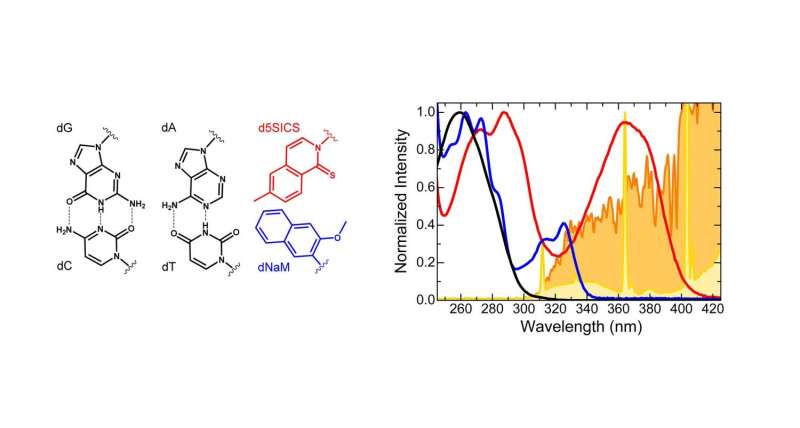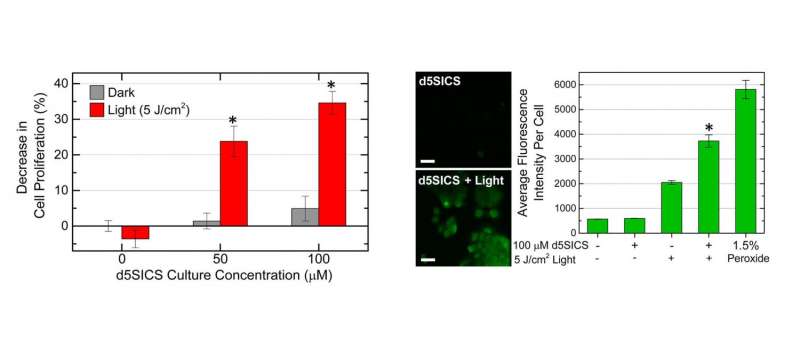September 12, 2016 feature
Unintended consequences of creating the world's first semisynthetic organism

(Phys.org)—In 2014, the incorporation of two artificial letters of genetic code into the DNA of Escherichia coli gave the bacteria the distinction of becoming the world's first stable semisynthetic organism.
The modification was intended to illustrate the possibility of enabling organisms to incorporate and replicate an artificial base pair for the future biosynthesis of novel proteins. But now in a new study, scientists have discovered that the artificial base pair has an unintended consequence on living cells: phototoxicity. The new results show that the artificial base pair makes living cells more susceptible to damage from low doses of sunlight and standard fluorescent light bulbs, leading to a significant decrease in cell survival and growth.
The study, titled "Unintended Consequences of Expanding the Genetic Alphabet," is published in a recent issue of the Journal of the American Chemical Society by a team of researchers led by Carlos E. Crespo-Hernández from Case Western Reserve University, along with coauthors from Case Western and Columbia University.
"There is currently an ongoing quest to genetically modify living cells and organisms with different purposes," Crespo-Hernández told Phys.org. "Our work clearly cautions scientists that care must be exercised when efforts are made to expand the genetic alphabet, especially if the synthetic organisms may be exposed to light—a fact that has been hitherto overlooked."
The artificial base pair consists of two nucleosides (which are nucleotides without a phosphate group) called d5SICS and dNaM. These artificial nucleosides have different chemical structures than the natural nucleosides, which are those made of the adenine, guanine, thymine, and cytosine nucleobases. Due to their different chemical structures, the artificial and natural nucleosides absorb light at different wavelengths. The artificial nucleosides strongly absorb light with wavelengths in the near-visible range, or just under 400 nm. In contrast, natural nucleosides absorb light most strongly at higher energies, those with wavelengths less than 300 nm.
Since everyday lighting, such as the sunlight that reaches Earth's surface and fluorescent light bulbs, contains much more light in the near-visible range than in the higher-energy ultraviolet range, we receive significantly greater exposure to light with near-visible wavelengths.

To investigate how this light absorption difference may affect living cells, the researchers in the new study performed an experiment with living cancer cells from human skin (epidermoid carcinoma cells). When exposed to a low dose of near-visible light, cells that had not been treated with the artificial nucleoside d5SICS exhibited no change in cell survival. Cells that had been treated with the artificial nucleoside, but not exposed to near-visible light, were similarly unaffected. But cells containing the artificial nucleoside that were briefly exposed to near-visible light exhibited a substantial decrease in cell proliferation, indicating that the artificial nucleoside had photosensitized these cells to near-visible light, resulting in photochemical damage.
Based on further investigation, the researchers think that one of the most probable mechanisms of the light-induced damage is that light exposure produces reactive oxygen species (ROS) inside the cells. High levels of ROS are known to cause cell damage, and the living cells containing the artificial nucleoside exhibited much higher levels of ROS upon exposure to near-visible light than untreated cells did.
Overall, the results illustrate the complexities involved in the ways that making even a small modification to an organism's genetic code may have far-reaching and unforeseen consequences for the entire organism.
The upside, however, is that some of the unforeseen consequences may have benefits if used in a controlled way. For instance, the researchers are currently investigating how the phototoxicity of the artificial nuceloside could be used as a method to treat cancer.
"The significant phototoxic activity of d5SICS in epidermoid carcinoma cells has the potential to open new opportunities for its use in topical photodynamic therapy applications, as our group and others have recently proposed for several nucleobase analogues," Crespo-Hernández said.
The authors acknowledge funding from the National Science Foundation CAREER Program (Grant CHE-1255084 and CHE-1539808).
More information: Marvin Pollum et al. "Unintended Consequences of Expanding the Genetic Alphabet." Journal of the American Chemical Society. DOI: 10.1021/jacs.6b06822
Journal information: Journal of the American Chemical Society
© 2016 Phys.org




















